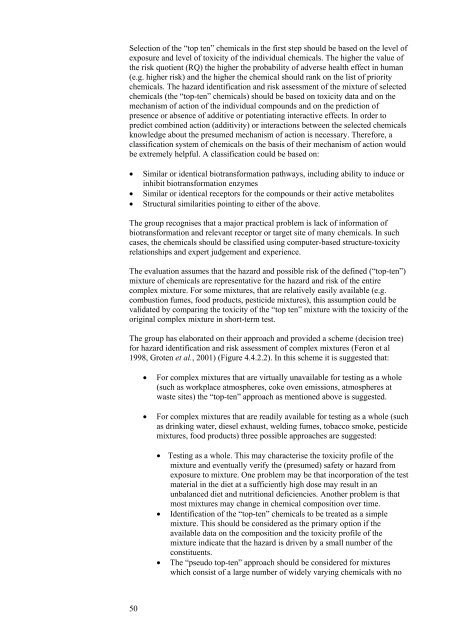Combined Actions and Interactions of Chemicals in Mixtures
Combined Actions and Interactions of Chemicals in Mixtures
Combined Actions and Interactions of Chemicals in Mixtures
You also want an ePaper? Increase the reach of your titles
YUMPU automatically turns print PDFs into web optimized ePapers that Google loves.
Selection <strong>of</strong> the “top ten” chemicals <strong>in</strong> the first step should be based on the level <strong>of</strong><br />
exposure <strong>and</strong> level <strong>of</strong> toxicity <strong>of</strong> the <strong>in</strong>dividual chemicals. The higher the value <strong>of</strong><br />
the risk quotient (RQ) the higher the probability <strong>of</strong> adverse health effect <strong>in</strong> human<br />
(e.g. higher risk) <strong>and</strong> the higher the chemical should rank on the list <strong>of</strong> priority<br />
chemicals. The hazard identification <strong>and</strong> risk assessment <strong>of</strong> the mixture <strong>of</strong> selected<br />
chemicals (the “top-ten” chemicals) should be based on toxicity data <strong>and</strong> on the<br />
mechanism <strong>of</strong> action <strong>of</strong> the <strong>in</strong>dividual compounds <strong>and</strong> on the prediction <strong>of</strong><br />
presence or absence <strong>of</strong> additive or potentiat<strong>in</strong>g <strong>in</strong>teractive effects. In order to<br />
predict comb<strong>in</strong>ed action (additivity) or <strong>in</strong>teractions between the selected chemicals<br />
knowledge about the presumed mechanism <strong>of</strong> action is necessary. Therefore, a<br />
classification system <strong>of</strong> chemicals on the basis <strong>of</strong> their mechanism <strong>of</strong> action would<br />
be extremely helpful. A classification could be based on:<br />
• Similar or identical biotransformation pathways, <strong>in</strong>clud<strong>in</strong>g ability to <strong>in</strong>duce or<br />
<strong>in</strong>hibit biotransformation enzymes<br />
• Similar or identical receptors for the compounds or their active metabolites<br />
• Structural similarities po<strong>in</strong>t<strong>in</strong>g to either <strong>of</strong> the above.<br />
The group recognises that a major practical problem is lack <strong>of</strong> <strong>in</strong>formation <strong>of</strong><br />
biotransformation <strong>and</strong> relevant receptor or target site <strong>of</strong> many chemicals. In such<br />
cases, the chemicals should be classified us<strong>in</strong>g computer-based structure-toxicity<br />
relationships <strong>and</strong> expert judgement <strong>and</strong> experience.<br />
The evaluation assumes that the hazard <strong>and</strong> possible risk <strong>of</strong> the def<strong>in</strong>ed (“top-ten”)<br />
mixture <strong>of</strong> chemicals are representative for the hazard <strong>and</strong> risk <strong>of</strong> the entire<br />
complex mixture. For some mixtures, that are relatively easily available (e.g.<br />
combustion fumes, food products, pesticide mixtures), this assumption could be<br />
validated by compar<strong>in</strong>g the toxicity <strong>of</strong> the “top ten” mixture with the toxicity <strong>of</strong> the<br />
orig<strong>in</strong>al complex mixture <strong>in</strong> short-term test.<br />
The group has elaborated on their approach <strong>and</strong> provided a scheme (decision tree)<br />
for hazard identification <strong>and</strong> risk assessment <strong>of</strong> complex mixtures (Feron et al<br />
1998, Groten et al., 2001) (Figure 4.4.2.2). In this scheme it is suggested that:<br />
50<br />
• For complex mixtures that are virtually unavailable for test<strong>in</strong>g as a whole<br />
(such as workplace atmospheres, coke oven emissions, atmospheres at<br />
waste sites) the “top-ten” approach as mentioned above is suggested.<br />
• For complex mixtures that are readily available for test<strong>in</strong>g as a whole (such<br />
as dr<strong>in</strong>k<strong>in</strong>g water, diesel exhaust, weld<strong>in</strong>g fumes, tobacco smoke, pesticide<br />
mixtures, food products) three possible approaches are suggested:<br />
• Test<strong>in</strong>g as a whole. This may characterise the toxicity pr<strong>of</strong>ile <strong>of</strong> the<br />
mixture <strong>and</strong> eventually verify the (presumed) safety or hazard from<br />
exposure to mixture. One problem may be that <strong>in</strong>corporation <strong>of</strong> the test<br />
material <strong>in</strong> the diet at a sufficiently high dose may result <strong>in</strong> an<br />
unbalanced diet <strong>and</strong> nutritional deficiencies. Another problem is that<br />
most mixtures may change <strong>in</strong> chemical composition over time.<br />
• Identification <strong>of</strong> the “top-ten” chemicals to be treated as a simple<br />
mixture. This should be considered as the primary option if the<br />
available data on the composition <strong>and</strong> the toxicity pr<strong>of</strong>ile <strong>of</strong> the<br />
mixture <strong>in</strong>dicate that the hazard is driven by a small number <strong>of</strong> the<br />
constituents.<br />
• The “pseudo top-ten” approach should be considered for mixtures<br />
which consist <strong>of</strong> a large number <strong>of</strong> widely vary<strong>in</strong>g chemicals with no

















